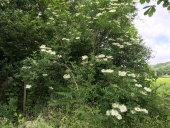
 5
5




Once you make a decision, the universe conspires to make it happen. - Ralph Waldo Emerson
 6
6




 3
3




Yanmar YM2610 Compact Tractor
Gardening like your life depended on it.
 3
3




 4
4




 3
3




Weeds are just plants with enough surplus will to live to withstand normal levels of gardening!--Alexandra Petri
 3
3




Some places need to be wild
 5
5




Try harder, fail better... stay golden.
Eventually everything connects, keep doing the things
 3
3




Eric Hanson wrote:It blows my mind that comfrey is considered to be a weed. I went way out of my way to plant it. In fact, my very first Permies post was about how to plant comfrey.
Eric
Once you make a decision, the universe conspires to make it happen. - Ralph Waldo Emerson




Some places need to be wild





 1
1




Joseph Lofthouse wrote:
I keep the purslane completely weeded out of most of my fields.
Once you make a decision, the universe conspires to make it happen. - Ralph Waldo Emerson

 1
1




 3
3




Determining the difference between Bockings 4 and 14 is done by consensus. It's like trying to identify the difference between twins.
"There are other spots on the web to get my fix proving someone is an idiot but no other place for what I get here." -- former permie Brice Moss, 2012.
 3
3




“The beautiful thing about learning is that nobody can take it away from you.” – B.B. King
 1
1




 2
2




Forever creating a permaculture paradise!
 5
5




Observation is where intelligence is born.
 3
3




![Filename: 3836D7A5-0C79-4522-8820-BDF54A0BF9CB.gif
Description: [Thumbnail for 3836D7A5-0C79-4522-8820-BDF54A0BF9CB.gif]](/t/154735/a/134300/3836D7A5-0C79-4522-8820-BDF54A0BF9CB.gif)

|
Rototillers convert rich soil into dirt. Please note that this tiny ad is not a rototiller:
A PDC for cold climate homesteaders
http://permaculture-design-course.com
|






